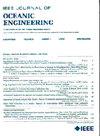面向现实应用:基于知识精馏的轻量级水声定位模型
IF 5.3
2区 工程技术
Q1 ENGINEERING, CIVIL
引用次数: 0
摘要
深度学习(DL)方法在水声定位(UAL)中得到了广泛的应用。虽然许多工作致力于提高定位精度,但他们忽视了基于dl的UAL问题固有的另一个关键挑战,即模型的实用性。高级深度学习模型通常具有极高的复杂性,需要大量的计算资源,导致推理时间较慢。不幸的是,海洋应用程序中有限的处理能力和实时需求使得复杂深度学习模型的部署极具挑战性。为了解决这一挑战,本文提出了一个基于知识蒸馏(KD)技术的轻量级UAL框架,该框架有效地减少了深度UAL模型的大小,同时保持了竞争性能。具体来说,使用注意机制和卷积神经网络(cnn)设计了一个专用的教师网络。然后,执行KD将教师网络中的知识提取到轻量级的学生模型中,例如三层CNN。在实际部署中,只使用轻量级学生模型。在轻量级框架下,与教师网络相比,学生模型的模型参数减少了98.68%,推理时间提高了87.4%,而预测准确率降至1.07%(97.55%)。此外,通过迁移学习检验学生模型的泛化能力,在两种不同的海洋环境之间迁移模型。与没有KD过程的模型相比,学生模型显示出更强的泛化能力,因为它可以仅使用10%的数据快速适应新的应用环境。本文章由计算机程序翻译,如有差异,请以英文原文为准。
Toward Real-World Applicability: Lightweight Underwater Acoustic Localization Model Through Knowledge Distillation
Deep learning (DL) approaches in underwater acoustic localization (UAL) have gained a great deal of popularity. While numerous works are devoted to improving the localization precision, they neglect another critical challenge inherent in the DL-based UAL problem, i.e., the model's practicality. Advanced DL models generally exhibit extremely high complexity, requiring a large amount of computational resources and resulting in slow inference time. Unfortunately, the limited processing power and real-time demands in oceanic applications make the deployment of complex DL models exceedingly challenging. To address this challenge, this article proposes a lightweight UAL framework based on knowledge distillation (KD) techniques, which effectively reduces the size of a deep UAL model while maintaining competitive performance. Specifically, a dedicated teacher network is designed using attention mechanisms and convolutional neural networks (CNNs). Then, the KD is performed to distill the knowledge from the teacher network into a lightweight student model, such as a three-layer CNN. In practical deployment, only the lightweight student model will be utilized. With the proposed lightweight framework, the student model has 98.68% fewer model parameters and is 87.4% faster in inference time compared to the teacher network, while the prediction accuracy drops to only 1.07% (97.55% $\rightarrow$
求助全文
通过发布文献求助,成功后即可免费获取论文全文。
去求助
来源期刊

IEEE Journal of Oceanic Engineering
工程技术-工程:大洋
CiteScore
9.60
自引率
12.20%
发文量
86
审稿时长
12 months
期刊介绍:
The IEEE Journal of Oceanic Engineering (ISSN 0364-9059) is the online-only quarterly publication of the IEEE Oceanic Engineering Society (IEEE OES). The scope of the Journal is the field of interest of the IEEE OES, which encompasses all aspects of science, engineering, and technology that address research, development, and operations pertaining to all bodies of water. This includes the creation of new capabilities and technologies from concept design through prototypes, testing, and operational systems to sense, explore, understand, develop, use, and responsibly manage natural resources.
 求助内容:
求助内容: 应助结果提醒方式:
应助结果提醒方式:


